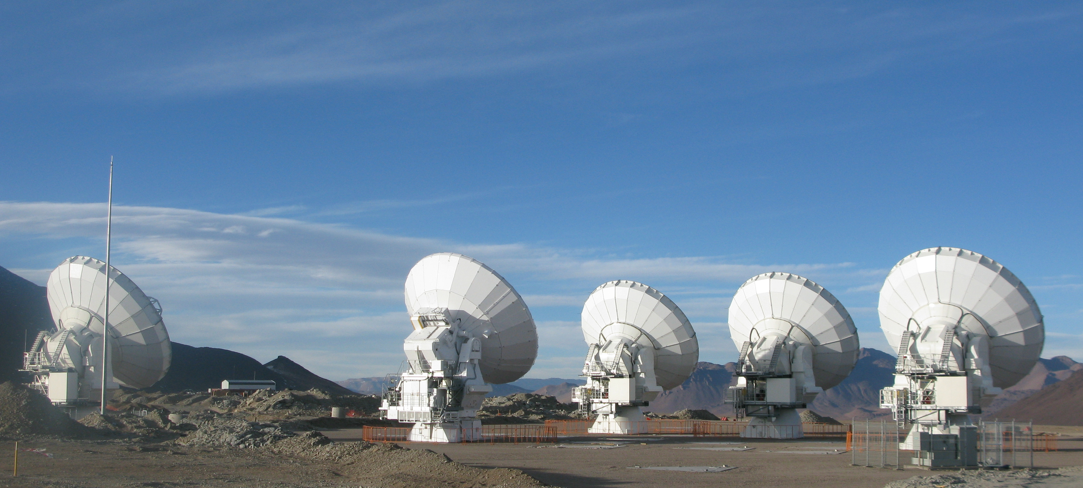ALMA
ALMA
 Image credit: ALMA (ESO /
NAOJ / NRAO) photo by Nick Whyborn, 3 June 2010.
Image credit: ALMA (ESO /
NAOJ / NRAO) photo by Nick Whyborn, 3 June 2010.
The Atacama Large Millimeter Array (ALMA) is comprised of 66 high-precision antennae, and is located on the Chajnantor plain of the Chilean Andes. The ALMA site offers the exceptionally dry and clear sky required to operate at millimeter and submillimeter wavelength. The quality of the observing site, combined with the unprecedented combination of sensitivity, angular resolution, spectral resolution and image fidelity made possible with ALMA, will enable astronomers to carry out transformational research in a wide variety of astronomical areas. The wavelengths covered by ALMA range from 0.3 mm to 3.6 mm (frequency coverage of 84 GHz to 950 GHz) - this range is essential for probing the first stars and galaxies, directly imaging the disks in which planets are formed, and probing the energy output from active supermassive black holes in extremely luminous starburst galaxies.
The superior capabilities of ALMA will include:
- At least fifty 12-meter antennas for sensitive, high resolution imaging
- Four additional 12-meter antennas, providing total power, and twelve 7-meter antennas comprising the ALMA C ompact Array (ACA), enhancing the fidelity of wide field imaging
- Imaging ability in all atmospheric windows from 3.6 mm to 0.3 mm (84 GHz to 950 GHz), with coverage down to 10 mm (30 GHz) possible through future receiver development
- Array configurations with maximum baselines from approximately 150 meters to 15 km
- Ability to image sources many arcminutes across at arcsecond resolution
- Top spatial resolution of 5 milli-arcseconds (better than the VLA and HST)
- Top velocity resolution better than 0.05 km/s
These capabilities will enable ALMA to achieve the following level one science goals are:
- The ability to detect spectral line emission from CO or
C+ in a normal galaxy like the Milky Way at a redshift of
z = 3, in less than 24 hours of
observation.
- The ability to image the gas kinematics in a solar-mass
protostellar/ protoplanetary disk at a distance of 150 pc
(roughly, the distance of the star-forming clouds in
Ophiuchus or Corona Australis), enabling one to study the
physical, chemical, and magnetic field structure of the
disk and to detect the tidal gaps created by planets
undergoing formation.
- The ability to provide precise images at an angular
resolution of 0.1″. Here the term "precise image" means an
accurate representation of the sky brightness at all points
where the brightness is greater than 0.1% of the peak image
brightness. This requirement applies to all sources visible
to ALMA that transit at an elevation greater than 20
degrees.
ALMA will be a complete astronomical imaging and spectroscopic instrument for the millimeter/submillimeter regime, providing scientists with capabilities and wavelength coverage that complement those of other research facilities of its era, such as the Expanded Very Large Array (EVLA), James Webb Space Telescope (JWST), Thirty Metre Telescope (TMT), European Extremely Large Telescope (E-ELT), and Square Kilometer Array (SKA). Specifically, ALMA will fill in a crucial scientific gap by providing a sensitive, high-resolution probe of the cold gas and dust properties of star-forming region in our Galaxy and other galaxies out of high-redshift, and in protoplanetary disks. These region are obscured at shorter wavelengths, thus ALMA complements shorter wavelengths observations by providing a complete picture of these cold regions in which stars and planets are formed.
Support for the North American community will be provided by the NRAO North American ALMA Science Center in Charlottesville, Virginia.




Connect with NRAO